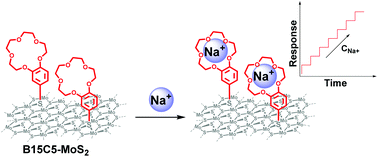An ion-selective crown ether covalently grafted onto chemically exfoliated MoS2 as a biological fluid sensor†
Abstract
We describe the basal plane functionalization of chemically exfoliated molybdenum disulfide (ce-MoS2) nanosheets with a benzo-15-crown-5 ether (B15C5), promoted by the chemistry of diazonium salts en route to the fabrication and electrochemical assessment of an ion-responsive electrode. The success of the chemical modification of ce-MoS2 nanosheets was investigated by infrared and Raman spectroscopy, and the amount of the incorporated crown ether was estimated by thermogravimetric analysis. Raman spatial mapping at on-resonance excitation allowed us to disclose the structural characteristics of the functionalized B15C5-MoS2 nanosheets and the impact of basal plane functionalization to the stabilization of the 1T phase of ce-MoS2. Morphological investigation of the B15C5-MoS2 hybrid was implemented by atomic force microscopy and high-resolution transmission electron microscopy. Furthermore, fast-Fourier-transform analysis and in situ energy dispersive X-ray spectroscopy revealed the crystal lattice of the modified nanosheets and the presence of crown-ether addends, respectively. Finally, B15C5-MoS2 electrodes were constructed and evaluated as ion-selective electrodes for sodium ions in aqueous solution and an artificial sweat matrix.



 Please wait while we load your content...
Please wait while we load your content...